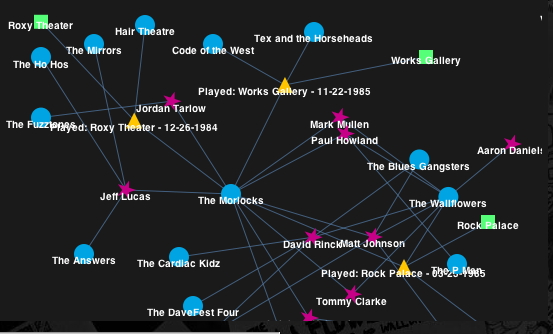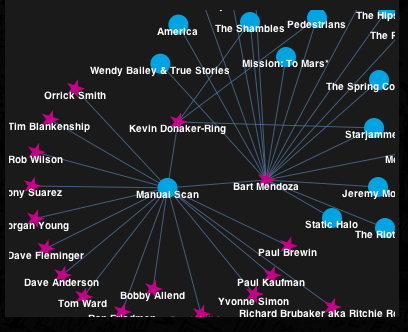Sceneroller is a social music discovery site of a different breed, and a phenomenal complement to the innumerable sites and blogs dedicated to bands and artists, as well as music delivery networks such as Pandora or Soundcloud, orDeezer in Europe. It expresses something that has rarely been captured: the social nature of the music scene. Sceneroller starts the collaborative writing and graphing of the history of local music scenes that connect bands, people, venues and gigs!
The project began with the Che Underground blog that depicts the San Diego underground rock’n'roll scene of the 1980s, where Sceneroller’s co-founder,Matthew Rothenberg, explored his own musical youth. Of the multiple bands that existed back then, only a few were visible online in historical records, and most had disappeared completely, while memories of tunes, thrill, and dramas still linger in the minds of the regulars involved in that scene – and influence newer generations. Albeit ephemeral in nature, music builds lasting bonds – so much so that three years later, the Che Underground site welcomes 16,000 visitors/month and has resurrected most of the San Diego scene. While working at it, Matthew, Jason Brownell and Jonathan Goldin (the other co-founders ofSceneroller) experienced the limitations of the linear blog format, narrated by one voice, and, where people can contribute, but are still dependent on an author. What came out of the blog was a desire from users to explore the scene in any direction they wanted. As a result, the founders of Sceneroller decided to better reflect the tribal world of music by also mapping the interconnections between bands, musicians, venues, and gigs (which they, in turn added to Che Underground) and let users participate in this encyclopedia at whatever level they could. As I looked randomly, I came across this map, showing the complex interconnections of a San Diego band that was active between 1984 and 1987, The Morlocks.
Bands are represented as blue planets that contain members (red stars) who can be musicians, people from the crew, and even fans. They perform in venues (green rectangles), which are themselves containers for gigs (yellow triangles). This approach addresses the limitations of standard family trees and enables readers to see how bands are related through shared musicians and gigs, and their audience within venues. By enabling users to navigate non-linearly,Sceneroller reveals connections that we may not even think of – and that the participants of those bands themselves may have been unaware of.
Sceneroller shows the long tail of the countless bands that never got signed to anything, got signed to independent labels or even to major labels, but never really made it — a sweet spot that basically corresponds to the music scene as we all know and enjoy it even if we attend the shows of famous bands now and then. The unknown or not-so-famous bands can last for years, even decades, either because their musicians have a day-job or made surviving from hand-to-mouth their lifestyle. But more importantly, they create the breeding ground from which a small minority ends up blossoming, where they honed their skills, or got their inspiration. Kurt Cobain, for instance, was a roadie (and remained a big fan) of The Melvins who started in 1983 and still exist 28 years later… And Scenerollerwill also be a catalyst for musicians to meet again, much like with the Che Underground prototype: “We had a reunion concert in May 2009 in San Diego,” says Matthew emotionally. “We hadn’t gotten together in 26 years.”
As I am exploring this extraordinary product, I can’t help thinking that Matthew, by recapturing the ceremonial aspect of the music scene and its surprising intricacies, is doing on a different register something that is somewhat reminiscent of what his father, the extraordinary American poet Jerome Rothenberg did with his ethnopoetics. Small or short-lived, larger or long-lasting (such as Manual Scan whose two main players started to play together in 1976), these unsung bands have framed the largest part of our music oral culture, whose structure and idioms result from the interactions of musicians, people, and places over time.
Sceneroller is in the making (still in Beta), and the company is fixing bugs or interface details. Graphing the music scene is a huge enterprise, so do not expect to find everything you are looking for. Don’t be pissed but, instead, contribute! You will undoubtedly already find gems that will make you smile: Roger McNamee, for example, or the indirect relationship between Siouxie and the Banshees and The Flowers of Romance via Budgie who played for The Slits withPalmolive … So help others discover such gems! For example, “the map of The Morlocks,” Matthew insists, “is based entirely on input from registered users. ANYONE can help curate music history as long as they’re registered. For us, the participatory nature of Sceneroller echoes the do-it-yourself ethos of local music scenes themselves. This is a digital version of the sort of conversation we all had in our respective music scenes when they first happened!”
Today, Sceneroller starts with rock’n'roll, simply because the founders are rock’n'roll musicians, and reaches back 1949 as the earliest date, but as Matthew puts it “There is no reason why this should be limited. I want jazz musicians to start to tell their story because I want to be open.” And then, Matthew added Philippe Kahn right under my eyes!
17 March 2011
No Musical Missed Connections through Sceneroller
My mother usually has me read over the posts of her blog before she publishes them (good blogging practice!). In general the articles - on Web 2.0 projects, tech conferences, business books, etc... - are relatively removed from my field of vision and my field of work (although an entrepreneur is entrepreneur, no matter the business, and many tenets of startup projects hold true for musicians). But her most recent post is very much on my turf. Sceneroller, a sort of musical family-tree and connections mapping website, is not centered in classical music, but its growing multi-layer database is a fascinating and potentially very useful tool for anyone interested in the music scene and its history. As such, I've stolen my mother's interesting post from Grade A Entrepreneurs to post here:
Subscribe to:
Post Comments (Atom)



That is so interesting. Have a lovely day, my dear
ReplyDeleteKisses